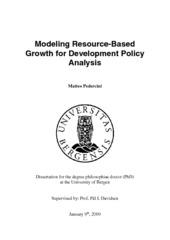| dc.contributor.author | Pedercini, Matteo | eng |
| dc.date.accessioned | 2009-10-06T07:53:36Z | |
| dc.date.available | 2009-10-06T07:53:36Z | |
| dc.date.issued | 2009-09-11 | eng |
| dc.identifier.isbn | 978-82-308-0861-0 (print version) | |
| dc.identifier.uri | https://hdl.handle.net/1956/3510 | |
| dc.description.abstract | This dissertation focuses on the design and implementation of simulation models fordevelopment policy analysis, to support a broader understanding of the development processand the identification of effective development strategies. Development is a complextransformation process. Some countries undergo this process rapidly and successfully, whileothers fail to do so. Research in this field indicates that policies that are inefficiently designedand implemented can affect the ability of a country to succeed. We argue that policy-makersrequire appropriate quantitative models to understand the development process in theircountry and to support the design of effective policies, and we propose a comprehensiveanalytical framework for the analysis of development issues.The studies presented in this dissertation illustrate how we develop, test, and implement aresource-based approach to development policy analysis. The resource-based approach,originally developed and broadly applied in the field of firms’ strategic management, has sofar known little application to the development field. We adopt a quantitative and dynamicresource-based approach, in line with current research in strategic management, and wefurther develop it and apply it to the analysis of development policies. We practicallyimplement our approach through the development of System Dynamics (SD) models that weapply to policy analysis. The use of the SD method enables us to properly represent theelements of complexity that characterize the development process. We emphasize in particularhow, by focusing on resources’ dynamics, our approach allows for the recognition of the keydevelopment mechanisms, to identify the relevant constraints, and to design effective policies.A key aspect of computer models for development policy analysis is the way they representthe process of growth underlying development. This first chapter initially describes thecontext and purpose of the work carried out as part of this dissertation. Section two discussessome limits to the applicability of current growth research – theory and empirical work alike –to development policy analysis. Subsequently, in section three we report the results of asurvey recently conducted among government officials from 12 sub-Saharan countries. Thesurvey indicates that growth theory is not consistently applied in practical medium and longterm planning exercises in most of the surveyed countries, also due to some limits of themodeling methods used. In sections four and five we argue that a dynamic, resource-basedapproach can complement current growth research, and can provide a broader perspective ondevelopment policy analysis; and that the SD method is well suited for the implementation ofsuch an approach. In section six, we provide an overview of our studies on the application ofthe resource-based approach and the SD method to various development issues. Finally, thelast section of the chapter summarizes our findings and points to the need for further researchin this area.The results of the analyses presented in this dissertation point to the value of the resourcebasedapproach as a framework for development policy analysis. In each study, the causes ofdevelopment failure or unintended policy outcomes are identified in the characteristics of themechanisms of resources’ accumulation. A variety of alternative scenarios are analyzed, and,based on their results, policy recommendations are provided. Such recommendations,although derived in different contexts, have some similarities: they generally tend to stress theimportance, for effective policy design, of characterizing development beyond the purelyeconomic perspective; and of considering its strong links with the social and humandimensions. Also, our results stress the value for development policy analysis of considering the inherent difficulties, including time lags, involved in the cumulative processes that bringabout development.Most of the studies collected in this thesis have been carried out for – and often incollaboration with – policy-makers, international organizations, and field’s experts fromdeveloping countries. This not only allowed us to design our models around the needs andquestions of the development stake-holders, but also gave us the opportunity to observe how –beyond the mere appreciation of the analytical results produced – the process of applying ourapproach contributed to stimulating the development debate. Designing effective policies is alearning process, in which the learning that occurs during the process is as important as theanalytical outcomes themselves. Our last study investigates ways to enhance such learning,and we believe this to be a fertile area for further research. | en_US |
| dc.language.iso | eng | eng |
| dc.publisher | The University of Bergen | eng |
| dc.relation.haspart | Paper I: Pedercini, M., 2009, A resource-based approach to development policy analysis: a cross-country analysis. Draft | eng |
| dc.relation.haspart | Paper II: Pedercini, M., 2009, Resource-based development policy analysis in Mali: alternative growth prospects. Full text not available in BORA. | eng |
| dc.relation.haspart | Paper III: Socio-Economic Planning Sciences 44(2), Pedercini, M.; Barney, G. O., Dynamic analysis of Millennium Development Goals (MDG) interventions: the Ghana case study. Published as: Dynamic analysis of interventions designed to achieve millennium development goals (MDG): The case of Ghana, pp. 89-99. Copyright 2009 Elsevier Ltd. Reproduced with permission. Accepted version. The published article is available at: <a href="http://dx.doi.org/10.1016/j.seps.2009.08.002" target="blank">http://dx.doi.org/10.1016/j.seps.2009.08.002</a> | eng |
| dc.relation.haspart | Paper IV: Pedercini, M.; Qureshi, M. A., 2009, A resource-based approach to modelling and simulation of income distribution: the case of Pakistan. Full text not available in BORA. | eng |
| dc.relation.haspart | Paper V: Pedercini, M., 2009, Migration and development: a resource-based approach. Draft | eng |
| dc.relation.haspart | Paper VI: Kopainsky, B.; Pedercini, M.; Alessi, S.; Davidsen, P., 2009, A blend of planning and learning: simplifying a simulation model of national development. Full text not available in BORA. | eng |
| dc.title | Modeling Resource-Based Growth for Development Policy Analysis | eng |
| dc.type | Doctoral thesis | en_US |
| dc.rights.holder | Matteo Pedercini | en_US |
| dc.subject.nsi | VDP::Samfunnsvitenskap: 200::Samfunnsgeografi: 290 | nob |



